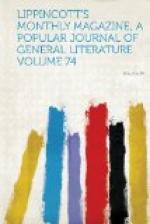Vienna is a faithful reflex in miniature of Austria in general. The heedless or untrained tourist, misled by names and language and the outward forms of intercourse, may pronounce the city a most delightful German capital: he may congratulate himself upon the opportunity it gives him of reviving his reminiscences of the old German emperors and contrasting their times with the present. But the tourist, were he to go beneath the surface, would discover that he is treading upon peculiar ground. We have only to scratch the Viennese to find something that is not German. We shall discover beneath the surface Hungarian, or Slavic, or Italian blood. A very large portion of the population, perhaps even the greater portion, speaks two, three or four languages with equal facility. New York excepted, no great city will compare with Vienna for medley of speech and race. The truth is, that the city still retains its early character as a frontier-post, or, to speak more correctly, it is the focus where the currents from North-eastern Italy, South-eastern Germany, Bohemia, Galicia and Hungary converge without thoroughly intermingling. The conventional German used by the middle and lower classes is interspersed with terms borrowed from the other languages, with dialectic idioms, provincialisms and peculiarities of pronunciation that cause it to sound like an unfamiliar tongue.
In outward appearance the city is not less diversified than in population. The gay bustle of the streets, the incessant roll of fiacres, the style of dress, the crowded cafes remind one more of Paris than of Germany. The cuisine and ways of living and the architecture here and there have borrowed freely from Italy and France. A certain fondness for gorgeous coloring and profuse ornamentation is due to Hungarian influence. The bulbous cupolas surmounted with sharply tapering spires, irreverently nicknamed Zwiebel-Thuerme ("onion-towers"), are evidently stragglers from Byzantium, and contrast sharply with the rich Gothic of St. Stephen’s and the new Votive Church. By the side of Vienna, Berlin is painfully monotonous. Few of the public buildings can be called handsome, or even picturesque. The plaster used for the outer coating of the houses is apt to discolor or flake off, so that the general aspect is that of premature age. Worthy of note is the new city hall, a successful effort to make an imposing and elegant structure of brick. In the neighborhood of the Thiergarten the private residences evince taste and refinement. Taken all in all, Berlin has not yet shaken off its provincialism, and is far behind Vienna in drainage, water-supply and paving. The Berlinese have much to do and undo before they can rightfully call their city a Weltstadt.




